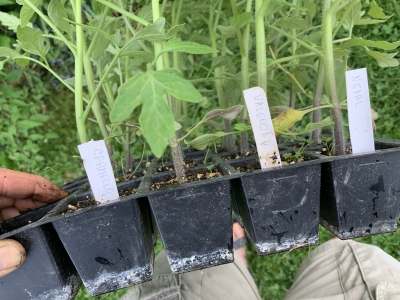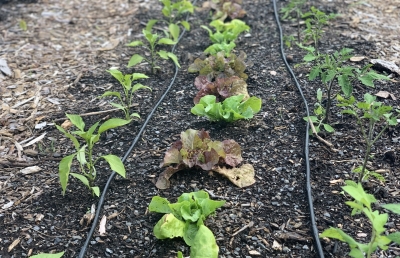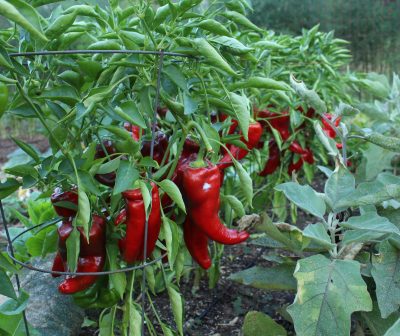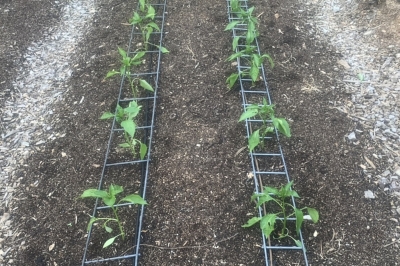GUT PLANTING
Not My Usual Approach
I couldn’t help myself, so yesterday I broke protocol. After quite a few days of bright sunshine with daytime temperatures in the 70s, even the 80s a couple of days, I went ahead and planted all the tomato and pepper plants that I’ve been nurturing since their birth a few weeks ago — six weeks for the tomatoes, ten weeks for the peppers. Looking ahead, warm sunny days should follow, with night temperatures are predicted to dip down only into the 50s.
My usual protocol has been to plant not with my gut, but with the calendar date. Over the years I’m come up with a detailed chart of when to sow and transplant different kinds of vegetables based on the average dates of the last killing frost. Here, that date is around May 21st. Or, it used to be. (That chart — which I included in my book Weedless Gardening — allows anyone anywhere to determine sowing and planting dates merely by plugging in the average date for the last killing frost for their garden. Last frost dates for specific locations are available online.)
As with other global warming trends, the average date of the last killing frost right here — meaning specifically in my garden, which is in a frost pocket — has been pushed back a week or more. In the past, I would wait until a week, even two weeks, after that last frost date to set tomato and pepper plants in the garden. The average frost date is just an average; that week or two made sure my plants wouldn’t be caught off guard by a clear, cold night that didn’t hew to averages and charts.
When it comes right down to it, early planting is a gamble. The odds were good, so I took the gamble. My actions were also shaded by my not wanting to repot all the seedlings that were soon to outgrow their containers, and my hankering to see my garden with lots of plants in it.
Frost or Freeze
The word “frost” allows for some wiggle room. You’d think it meant any temperature below 32 degrees Fahrenheit. Not so. Temperatures between 29 and 32 degrees could be called a “light freeze.” Peppers and tomatoes sufficiently toughened up (“hardened off”) with some exposure to bright sunlight, cool temperatures, and wind can cruise right through a light freeze unscathed.
Moderate freezes, 25 to 28 degrees F., would cause some damage. A severe freeze, with temperatures below 24 degrees F. spells trouble for any tender vegetables plant. Sufficiently hardened off cool season plants, such as cabbage and its kin, lettuce, and chard, are usually fine even at those temperatures.
In all this, whether or not damage or death occur must factor in how fast cold descends on the garden, and how long it sits around.
At this point, I’m confident that my plants will be fine. If Ol’ Man Winter decides to peek in again, I can always throw a cover — flower pots, sheets, row cover — over the plants to protect them from cold.
Upright Pepper Plants
Let’s shift gears and take a look at growing peppers, specifically, keeping them upright. My pepper plants, and perhaps yours, become top heavy with their weight of maturing fruit. Mine especially so because I don’t pick any until they have fully matured, turning red or whatever other color they sport at full maturity. Especially prone to toppling is the variety Sweet Italia, which I grow because of its especially luscious fruits which also ripen early.
I’ve tried various methods of keeping Sweet Italia’s fruit laden stems up. In the past, I grew them in those cone shaped, wire cages often sold for tomatoes, for which they are useless. Those cages get tangled together in storage and make weeding very difficult. My bamboo provides an excess of stakes of various thickness; three stakes next to a plant does keep the plant upright, but not its fruit-laden arms.
Twine woven in among the plants and tied to metal stakes set a few feet apart along the row held plants and most arms up, but scrunched everything together too much, cutting down light penetration.
This year my plants are going to stand up with the help of livestock fencing panels, cattle panels with 6×8 inch openings, and goat and sheep panels with 4×4 inch openings. With a bolt cutter I clipped them into one-square-wide strips. Each bed is home to two rows, about 20 inches apart, of peppers, with plants set 16 inches apart in the row. Sixteen inch spacing allows me to set the panel strips centered over the plants. For now the strips are on the ground beneath the plants.
Once the plants grow large and start extending their arms, I’ll raise the strips with some bricks set every few feet as high as needed to do their job.
I hope this works, and welcome any comments on the prognosis. Do you have a method for successfully keeping your peppers from toppling or resting too many fruits on the ground? Perhaps your peppers grow unaided?


Not sure if there’s a difference between light frost vs light freeze. What is the air temperature for a light or damaging frost?
Depends on the plant.
I use concrete reinforcement wire, same thing I use for tomato cages, and just make them shorter and a bit narrower in diameter. For shorter plants, I use an 18″ cage and for tall peppers I’ll use one that’s 30″.
I’m not familiar with Sweet Italia. I’ll have to give it a try next year. The best tasting peppers I grew last year were Rewia (https://www.rareseeds.com/rewia-pepper) and Apple Elongated (https://www.fedcoseeds.com/seeds/apple-organic-elongated-sweet-pepper-3764). Neither was super prolific, but the flavor of both was excellent.
Thanks for tempting me to try another pepper variety.
Hi Lee,
Because I have an evidently endless supply of bamboo I build a fence for the peppers and the tomato plants. Five posts of seven feet high or so and five or six horizontal rails running about fifty feet in length. Three runs and I’m all set. Everything gets tied to the rails. Burn the entire works in the winter and do it again come spring.
Aside:
Any credence to the “plant by the phase of the moon” thinking?
Sound like it’s very attractive. Bamboo is pretty is so many ways and uses. I don’t lend credence to “moon planting.”
I primarily use 6 foot wire panels, cut to fit the particular plant. One time inexpensive purchase and easily stored in the off season. The idea is to use the inexpensive and/or reusable materials at hand in the construction. I have successfully used fruit tree and grapevine trimmings in the construction of trellises. It doesn’t have to be pretty as long as it is functional, will support the plants and provide easy access for maintenance and picking.
I have found the Green Tomato Tape works well but is a bit costly. Better is big ball of inexpensive, 100% All-Natural Cotton Yarn. Not only it extremely cost effective, it works well on plants for both strength and give. For under $3 you can get 100 yards of yarn, perfect for tying up any Vegetable plants! Best of all, if you purchase it in Green, it is pretty much invisible in the garden and at the end of the season. when you are removing the spent vines, it will break down in the compost pile.
I buy a bale of baling twine when my old bale gets used up. It lasts a long time!
I use those useless metal tomato cages, but I put them upside down and anchor them with those ‘earth staples’. The pepper plants grow right up through the cheap cages and the horizontal rings support the branches. This works for me – and also keeps the dogs from knocking into the plants.
I didn’t like trying to weed with the cages.
I LOVE the idea for using cut cattle panels/bricks in the pepper bed. Ladder mesh seems to have disappeared from our box stores or I might consider that also. Previously, I have successfully used the french weave for my peppers but the stakes are hard for me to remove at the end of the season.
Thank you so much for yet another garden improvement idea.
The livestock panels are heavier gauge than ladder mesh. Only problem is that they need to be cut, and there’s wastage.
Thanks for the frost/freezing temp guidelines. This will help me in my location in the Black Hills of SD.
I read the upright pepper piece with interest. Wondering if you have a trick for green beans and peas. We have tried string and chicken wire, but both become useless when the plants become heavy with beans.
I describe my pea fencing at here . Still working on my pole beans.
Watching the Gardners World show with host Monty Don, one episode showed a professional dahlia grower who stretched horizontal netting at a height of about 24″ high to support the rows of plants. Maybe that would work.
I was thinking of that, but the stock panels need less support because they are so rigid.